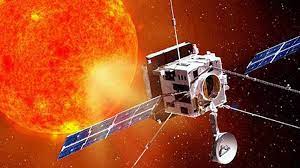The highly- estimated Aditya L1 spacecraft is scheduled for liftoff at 11:50 am on September 2 from Sriharikota in Andhra Pradesh, India. This cutting-edge mission, launching from Sriharikota in Andhra Pradesh, will embark on a remarkable odyssey, positioning itself an astonishing 1.5 million kilometers away from Earth. There, it will gracefully enter a halo orbit around Lagrange Point 1 (L1), a stable celestial location nestled within the Sun-Earth system.
The overarching objective of the Aditya L1 mission is nothing short of revolutionary: to meticulously scrutinize our nearest star, the Sun. Its focus will be on the Sun’s three distinct layers – the photosphere, chromosphere, and the outermost region, the corona. To accomplish this ambitious feat, the spacecraft is equipped with an array of sophisticated instruments, including electromagnetic detectors, particle sensors, and magnetic field analyzers. These advanced tools promise to unveil unprecedented insights into the Sun’s intricate behavior.
Stay tuned for comprehensive updates and captivating facts about the Aditya L1 Mission as it gracefully unfolds its mission. This ambitious endeavor holds the key to unraveling the Sun’s enduring mysteries, and we are committed to keeping you well-informed every step of the way.
As we draw nearer to the launch of India’s Aditya-L1 solar mission, the significance of this endeavor cannot be overstated. Professor Ramesh R from the esteemed Indian Institute of Astrophysics underscores its importance. He elucidates the potential impact of Coronal Mass Ejections (CMEs) emanating from the Sun on satellites orbiting Earth. Professor Ramesh emphasizes the critical nature of comprehending the ever-changing solar atmosphere and its magnetic field variations for accurately predicting solar flares. Typically, we observe two to three CMEs daily, a number that can surge dramatically to 11 to 12 during periods of heightened sunspot activity.
The primary scientific objectives of the Aditya-L1 mission are nothing short of audacious and illuminating. This mission seeks to unravel the enigmas of the Sun’s uppermost layers, encompassing the chromosphere and the corona. It will delve deeply into processes like heating, coronal mass ejections, and solar flares. Moreover, the mission will closely scrutinize the in-situ particle and plasma environments to attain a profound comprehension of solar particle dynamics.
Aditya-L1 will embark on a voyage into the intricacies of the solar corona and its heating mechanisms. It will employ diagnostic instruments to measure parameters such as plasma temperature, velocity, and density. This scientific venture will scrutinize the development, dynamics, and origins of coronal mass ejections (CMEs) while elucidating the sequence of events that culminate in solar eruptive phenomena. Furthermore, the mission will chart the magnetic field topology within the solar corona, contributing invaluable insights into the drivers of space weather, including the origin, composition, and dynamics of the solar wind.
The Aditya-L1 mission is furnished with seven scientific payloads, each meticulously crafted to scrutinize diverse aspects of the Sun. These payloads encompass a diverse spectrum of instruments, from electromagnetic detectors to particle sensors and magnetic field analysers. Collectively, these tools will empower scientists to conduct in-depth research into the mechanisms governing the heating of the solar corona, the acceleration of solar wind, and the properties of the Sun’s magnetic field.
One of the strategic advantages of the Aditya-L1 mission is its chosen location at Lagrange Point 1 (L1), situated approximately 1.5 million kilometers from Earth within Earth’s orbit. This strategic positioning between Earth and the Sun offers a stable vantage point for uninterrupted and continuous observations of the Sun. This unique position renders it an ideal observatory for real-time studies of solar activities, such as solar flares and coronal mass ejections.
The Aditya-L1 mission, on the brink of its launch, is poised to embark on a 125-day journey to reach Lagrange Point 1 (L1). For those eager to witness this momentous event, ISRO has thoughtfully provided an official registration link at lvg.shar.gov.in. Visitors will have the exclusive opportunity to observe the launch from the Launch View Gallery at Sriharikota and explore the Space Museum, an exhibition showcasing India’s illustrious history in space programs and its visionary plans for future space exploration.
In terms of scientific instruments, the Aditya L-1 mission boasts seven payloads, each meticulously designed to fulfill specific research objectives. These payloads include SoLEXS and HEL10S, tasked with analysing X-ray flares, SUIT, responsible for imaging the solar photosphere and chromosphere, MAG, equipped to measure magnetic fields, ASPEX and PAPA, dedicated to the study of solar wind and energetic ions, and VELC, designed to observe the solar corona and dynamics associated with coronal mass ejections. These payloads are the result of collaborative efforts between various esteemed Indian research and space institutions and ISRO.
The Aditya-L1 mission marks a monumental milestone in India’s pursuit of space exploration, promising to significantly enhance our understanding of the Sun and its profound impact on Earth and space weather.






